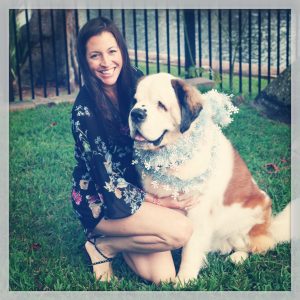
Friday’s Question- Ask the Veterinarian
Question for the Freckled Veterinarian:
I have an aging dog that is approaching 14 years old and have noticed some obvious behavioral changes? Sometimes I will find him staring at a wall for a long period of time. He does not appear to be lucid or know his whereabouts. In the evening when we are trying to sleep, he has started pacing and barking and I cannot seem to calm him down. I have also noticed he is having more accidents in the house. Are these common age related problems and is there anything I can do to help my pet?
Dr. Alison’s Answer:
This is a great question and unfortunately something I see all the time with my aging dogs. It is a difficult topic to discuss with my patient’s family, but there are ways we can help. First and foremost it is imperative to have your pet evaluated by your veterinarian. Full blood work and possibly imaging diagnostics will be recommended to rule out behavioral changes associated with cancer and or other illnesses. Pets are sometimes diagnosed with Cognitive Dysfunction Syndrome (CDS), or dementia once other diseases have been ruled out. Cognitive Dysfunction Syndrome is a condition in which the brain undergoes degenerative changes that result in a decline in thinking, recognition, memory, and learned behavior. It is a common condition, and unfortunately 50% of dogs will exhibit one or more symptoms of CDS. The disease tends to be progressive with signs worsening as pets age. The most common clinical signs associated with this disease are:
Early Stages:
- Reduced activity
- Changes in sleep patterns
- Reduced responsiveness/apparent deafness
- Changes in behavior
- A change in the interest of food
- Difficulty navigating their regular environment
Late stages:
- Persistent early stage symptoms
- Confusion/disorientation
- Inability to recognize familiar people
- Increased thirst
- Loss of bladder or bowel control
- Standing in corners or facing walls
- Wandering aimlessly
- Agitation/aggression
- Excessive barking
Treatment options are limited however there are some medications and activities that can help.
Activity and Stimulation:
First and foremost the most important thing you can do is keep your pet stimulated and active. Make sure you are engaging in daily activities of training, exercise, and stimulation. This is by far and away the most responsive form of treatment for CDS. The other treatments can be divided into natural remedies, such as herbs or supplements, diets, and medications.
Natural Remedies:
Neutricks– Neutricks (apoaequorin) supplements proteins that are lost in the brain in older pets, and helps support cells during this natural process of aging.
Senilife– A blend of anti-oxidants that protect the brain cells from damage.
Omega 3 Fatty Acids– Shown to have anti-radical effects and prevent the breakdown and degeneration of brain cells.
Diet:
Hills Science Diet B/D- This is a complete balanced diet that offers high levels of omega 3 fatty acids which has been proven to help prevent damage to brain cells from free radicals. Speak with your veterinarian about this prescription diet.
Purina Bright Line- Although not as effective as a Hills diet, this is a more economical option.
Medications:
Anipryl (Selegiline)– This is an irreversible inhibitor of monoamine oxidase (MAO), which causes improved mood through improved brain cell communication. Therapeutic effects of selegiline are thought to result in part from enhanced nerve function and increased dopamine levels in the brain, which can help with symptoms of dementia.
Anti-anxiety medications– Many times pets will exhibit anxiety along with the typical signs of CDS. Speak with your veterinarian regarding these medications to help with the anxiety component of the disease.
We want to give our pets the best quality of life and although CDS is irreversible and progressive, we need to do what we can to help our aging pets love their remaining days, and to continue to research ways to control or end CDS. The treatment options above are most effective when given at the first onset of clinical signs. The earlier you begin these treatment protocols with your pet, the more effective they will be. It is imperative to speak with your veterinarian regarding what your pet is experiencing, have them diagnosed correctly, and get the proper treatment options before doing anything at home. I hope this helps with your journey!





